A birthday card arrived in the mailbox.It came from my longtime friend J, whom I met while attending Pepperdine University (45 years ago). She drew a scene where we recently saw a movie on the card.The scene is as follows:Eric was buying our tickets, and the person selling them asked my friend J and me…
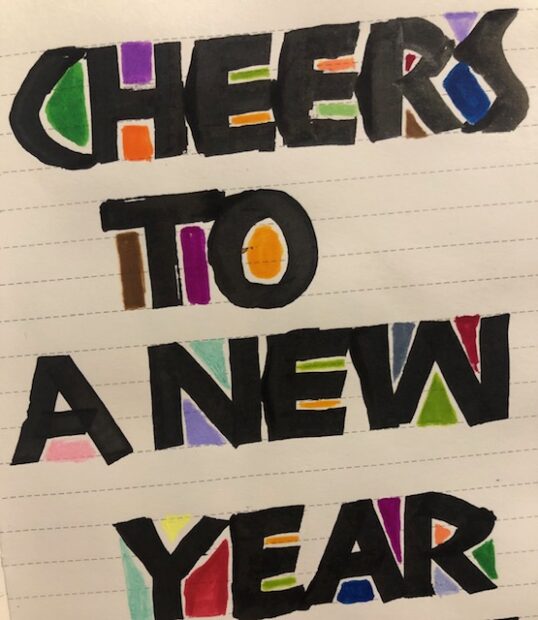
New Year Goals – Ink Making
January is the time for me to write down my goals for the new year.
I have been going to see New Year Sunrise to worship it on New Year’s Day for about 30 years.
I plan my new year goals according to the lunar calendar, so I spend the time until the Lunar New Year in February with an awareness of what I want to do in the New Year.
January is the perfect time to start writing down what’s on my mind, what I am thinking, and what I am feeling. I like writing down my goals and what I can accomplish.
Review what I wrote last year and see what I accomplished and didn’t.
If I had a goal that I couldn’t achieve last year, look at it honestly and think about whether I want to work towards the same goal this year.
Sometimes, my interests and feelings change, and I don’t continue. It’s a good experience to accept things and my changes and not judge them.
One of my goals in 2024 is to “Learn How to Make Ink” with natural materials by taking a workshop at Maiwa School of Textiles with TIM McLAUGHLIN.
Why did I decide to take this workshop as my New Year goal?
Well, something happened when I was five, and my parents changed the kindergartens I was going to. There was a famous Japanese calligraphy “Shodo” master who was the younger brother of the director of the new kindergarten I started attending.
I began learning Japanese calligraphy, “Shodo,” under this master.
At the beginning of the classes, I had learned how to make Sumi ink and doodling with a Japanese Calligraphy brush.
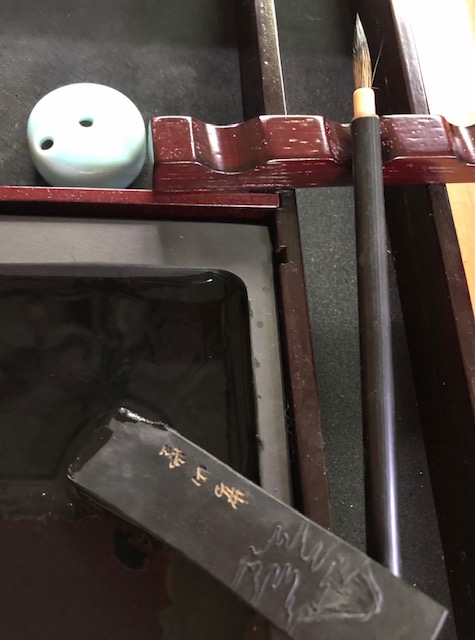
For some reason, I liked mixing Sumi ink stick with water and rubbing it by hand on an ink-stone.
I forget how much time passed when I was rubbing the Sumi ink stick, and my teacher sometimes came to check on me and said, “Are you ready to dip your brush in Sumi ink?”
Maybe I was in a zen state even at a young age, hahaha!
It could be because the scent of Sumi ink and the sound of Sumi ink rubbing the Suzuri (Inkstone) relaxed me.
I discovered that I could make Sumi ink darker than midnight color and Sumi ink color to match dawn, which was closer to gray.
The color of the Sumi ink changed depending on the movement of my hand and the vibration of my feelings.
Slowly moving my hands and making ink gave “the shy little Sanae” confidence and helped her calm down.
There was a time when my teacher encouraged me to exhibit many of my works in calligraphy exhibitions at art museums, and I won numerous awards.
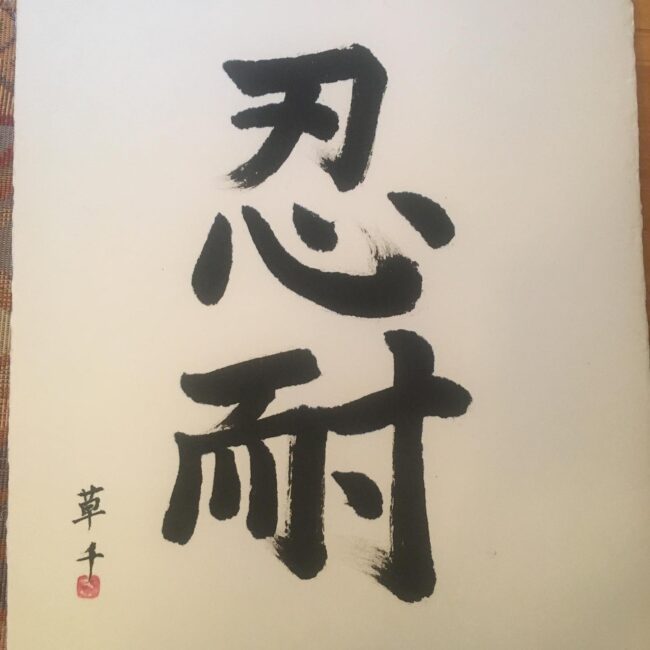
Japanese Calligraphy “Shodo” – 「Nintai」English meaning Patience I did for a friend request
Then, when I was in elementary school, I noticed that my father used fountain pens, and I was drawn to them so much. I remember buying my first fountain pen when I was 13 years old.
I wanted to find my favorite color of ink for my fountain pen.
Green ink was the color for me!
After finding green ink, I sent postcards and requested songs every week to the late-night radio program “Ama-chin’s Young Request” in my hometown of Nagoya.
I could request songs over the phone, but since so many people were calling, I couldn’t always get through, so I sent postcards.
I am sure I was spending more time writing these postcards than studying for school.
I used my pen name, “Green Puff” (this name came from the popular Japanese cotton facial puff name Clean Puff) because I used a green ink fountain pen, and it sounded cute.
Since everyone sent postcards with a ballpoint pen and no one sent them with fountain pens and colored ink, especially green, DJ Ama-chin chose my card every week and played my favorite songs. It was a sweet memory I almost forgot.
September 8th, 2001, I had a near-death experience in a car accident with severe injuries, and the doctors told me I would not be able to walk anymore. You might be able to imagine how much I struggled for a long time. I was bedridden for one year, painful physical therapy, and learned to live a wheelchair life.
One day, right after I learned to use my wheelchair, I went to orientation for disabled people’s public city van. I met a woman whose name was Evie, and she introduced me to taking a pen calligraphy class at Emeritus at Santa Monica College. This story you can read here.
Although it is different from Japanese calligraphy, I thought the attitude of preparation and writing was similar.
It calms the mind and makes the atmosphere quiet.
While I practice calligraphy, I notice my dogs and cats family all relax.

One of my calligraphy and drawing of Lindisfarne Gospel from my practice notebook.
I continue to practice pen calligraphy, and a few years ago, I was able to write my own haiku in pen calligraphy and submit “Lotus” with a watercolor hanga print as my first artwork for the college art show.

It reminded me of the old days when I was entering my “Shodo” Calligraphy yo the museum.
So, even though I was disable I still could create art.
There is one more thing, which is ever since I mixed ink colors at Kakimori’s Inkstand in Tokyo in 2019 after undergoing six cycles of Chemotherapy to treat Stage IV Non-Hodgkin’s Lymphoma cancer when I was diagnosed with “Only Weeks to Live” in 2017. (you can read it here)
The Inkstand had ten basic colors to create/mix many colors, and I was fascinated to create three different colors of my own.
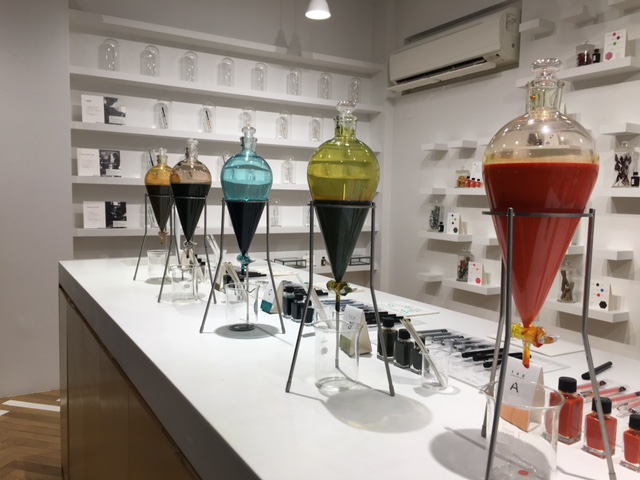

I was also interested in whether there was a way to make ink (not just mixing) using natural dye materials.
I was excited to learn that Maiwa School of Textile was offering “The Ink Making Workshop.”
I want to make my original “ink” colors someday and hope to be able to create new calligraphy art for college art exhibitions.
So, these are the reasons why I have made “Learn How to Make My Ink” one of my goals for 2024.
It is a seven-week workshop and it has just started.
The first week was Introduction and Module 1, in which I learned what materials and supplies I needed to prepare for making ink.
I am someone who loves glassware; my excitement grew when I saw that the list included glasses such as beakers, flasks, and cylinders.
I liked the fact that I could use rainwater to make ink.
The perfect timing is that it had been raining the last few days here, so I corrected the rainwater.
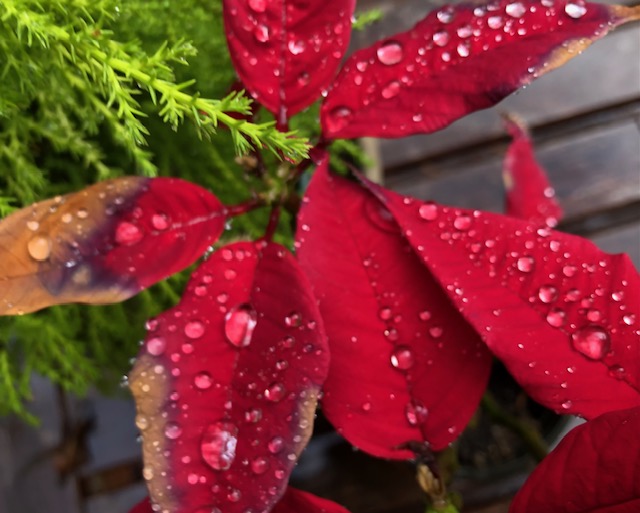
Raindrops over holiday poinsettia.
This weekend, I got all the materials and supplies to start making Gum Arabic Solution and Shellac Solution.
Doesn’t these glass containers remind you of a chemistry class?
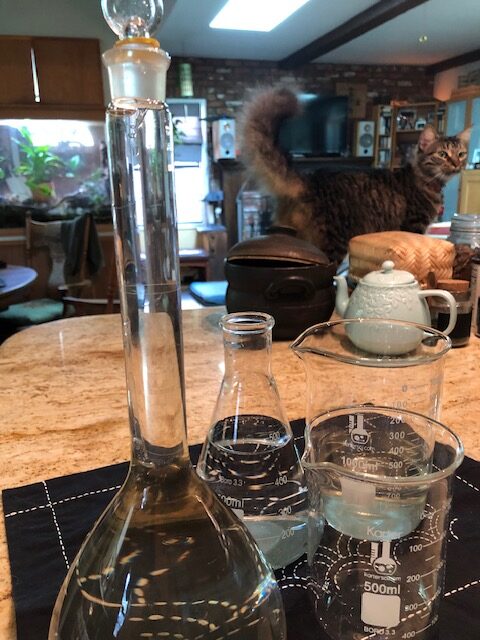
Making Gum Arabic Stock Solution was like making almond milk late and took only a little time.
Shellac Stock Solution was like making caramel syrup first.
The instructor, Tim, said,” It would take one hour to make,” but it took me almost two hours. I think my bath water to melt Shellac was not deep enough, so I will know the next time.
Anyway, I enjoyed a slow pace on Sunday time to complete it.
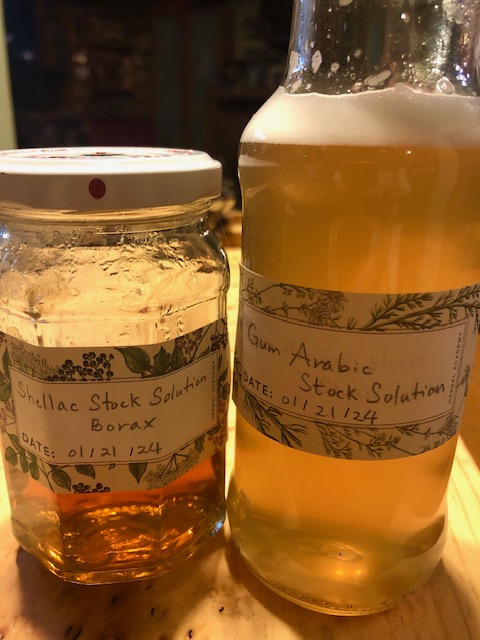
This workshop has been much more exciting than I expected so far.
I can’t wait to make my original color ink.
I look forward to posting more photos on my Instagram and Facebook and writing about them on my blog again after I learn.
Love,
Sanae ❤️

New Year Sunrise Worship in 2024
Ever since I was little, I’m not good at continuing to do the same thing for a long time, and I tend to stop what I’m doing and do something else in the middle.
My mother told me that I get bored quickly.
However, even if I stop midway through, I don’t wholly stop; instead, I restart again later, which is a somewhat troublesome trait that my mother did not understand.
As I get older, I restart and finish more and more things.
Having said that, there aren’t many things I’ve been able to continue doing for a long time, but something I am continuing…
I keep my treasurable items for a long time, like my first T-shirt that I bought when I was 16 years old, my first cobalt blue single flower base that I purchased in Nagasaki 40 years ago,
Raising dogs and cats for over 40 years,
it’s been almost 39 years since I stopped drinking alcohol,
I have been with Eric for 33 years,
31 years since I started macrobiotics,
it’s been 30 years since I started going to see the New Year sunrise, and it will be nine years since I started writing my blogs.
That’s all I can think of right now.
New Year’s Sunrise is something spiritually connected to me.
The weather forecast said it would be cloudy this year, and I wasn’t sure if there would be a New Year sunrise that I could see, so I didn’t have a strong desire to wake up at 5 am.
But I woke up at 5 am without hesitation, did a body scrub, and got ready.
Last year, our dog daughter, Lumi (a golden retriever who will turn 14 this January), couldn’t go to see the first sunrise because she could not walk much due to arthritis, but she was the opposite of me and had so much desire to see the New Year’s Sunrise and had been waiting since New Year’s Eve to go this year.
Looking at Lumi, I received hope and strength that I could go even if I didn’t have a strong desire to go.
We live in a world where many things are happening all over the world at this very moment.
The daily news reports, wars, sad, horrible things, and various crimes without our choice.
In the midst of all this, I was able to accept that it’s okay for me to be someone who can’t feel things more clearly. I focus on what is really important to me, so when my feelings are unclear, I accept them as they are and observe them mindfully.
It was cloudy, but it wasn’t raining.
When we arrived at the mountain, Eric parked his car and started walking in the dark trail with a flashlight. I could clearly see the Santa Monica early morning city lights.
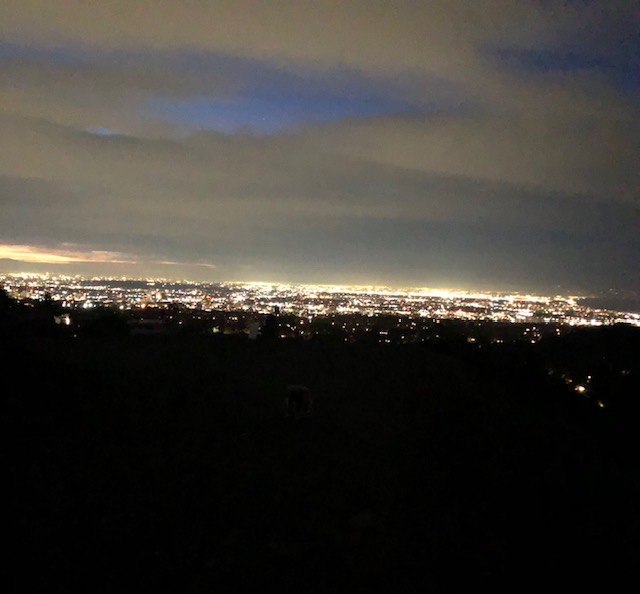
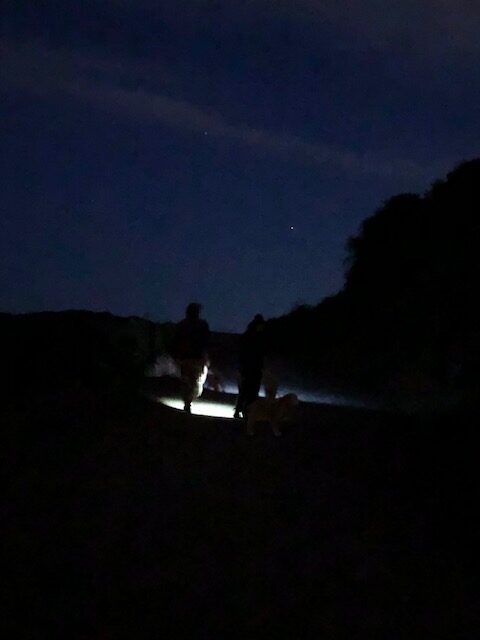
Lumi’s arthritis was getting better, but since she was walking at a slow pace, it took quite some time to reach the top.
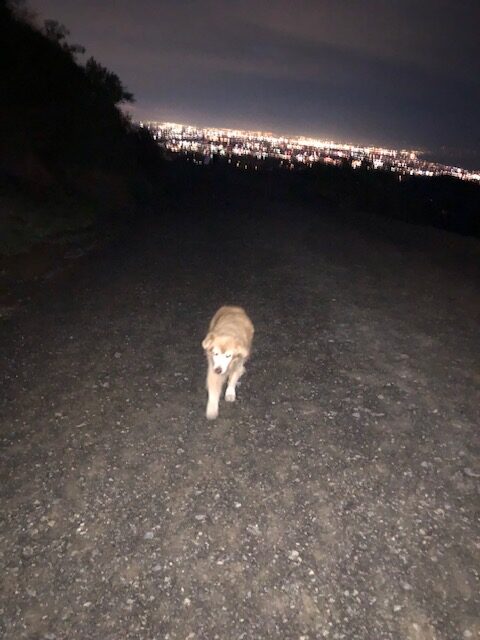
This year, in addition to Lumi, Lumi’s daughter Happy, our dog son Kai, and Kai’s son Lani are also with us. Also, Angel, who helps me with my garden, and his friend Emmy, who works at an organic farm, joined us.
When we reached the top, we could already see New Year’s sunrise reflections with blight red-orange on the back of the mountain. We got so excited.

There were large clouds, but the break in the clouds was right where we could see the first sunrise on the mountain, and we were all convinced that we could see New Year’s Sunrise.
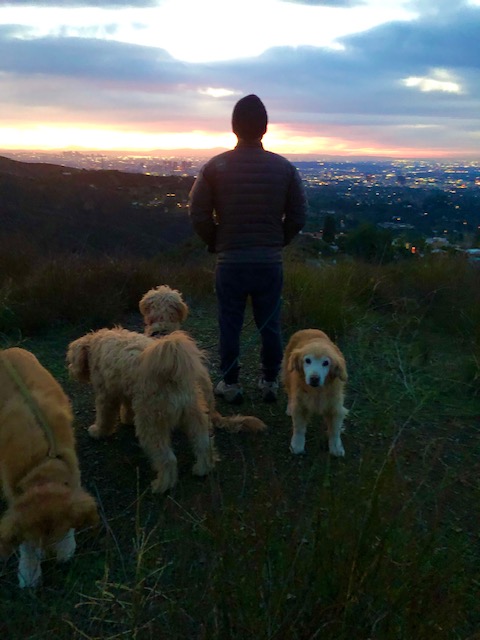
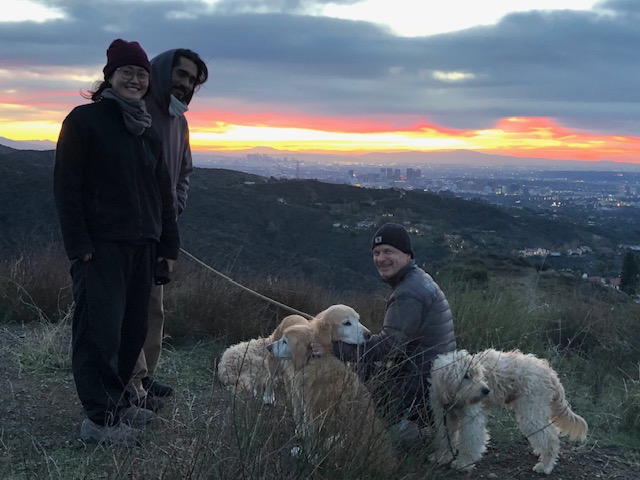
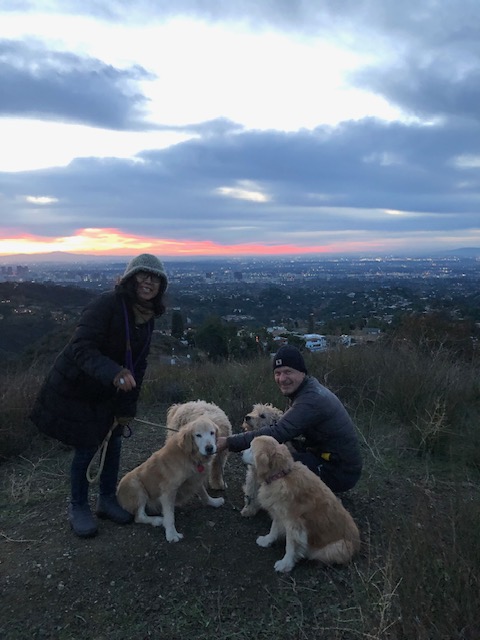
Every year, people like us come to see the first sunrise of the year, and others have started to arrive little by little.
Then one of them came close to me and said to me, “You come here every year to see the sunrise, right?”
When I answered, “Yes,”.
She said, “I met you before here. You have a restaurant, right?” I said, “Oh, we met here before? I am sorry I do not remember. We closed the restaurant.”
She said, “That’s too bad.”
Immediately, I said, “I’m not disappointed at all. With the restaurant closed, we have more time and less stress, and I enjoy every day my time.”
The answer came back from her, “I understand. I also run a business, but I’m considering closing it.”
She continued, “I met you here once New Year’s Sunrise morning, and you sent me a photo of the New Year’s Sunrise. It’s my favorite photo, and I still use it as my screen saver. Thank you for sending it!”
When I was in college, I studied communication and photojournalism. I love taking photos and used to carry around Nikon and Canon cameras.
So I often got asked to send photos to various people, and I sent them. I didn’t remember the person, but she remembered that I had a big camera with me, and I was happy to know that someone out there valued the things I had almost forgotten.

New Year’s Sunrise rose elegantly.
Because of the clouds, it did not appear at the time of sunrise, 6:59 am, but the sharp beams appeared at 7:03 am, and she showed up between the clouds for us!
*New Year Sunrise Worshipped with deep feelings and prayed to the gods of the north, south, east, and west for a bountiful harvest, good health and peace in 2024.
*The custom of worshiping the New Year Sunrise is said to have become popular after the Meiji period (1868–1912).
But it was first called “Shihohai” and began when the Emperor woke up early in the morning on New Year’s Day, purified himself, and prayed to the gods of the east, west, south, and north for a good harvest and good health. It spread from the court nobles to the ordinary people around the Heian period (710~1192).

The beams got stronger!

Then the beam got calm down.

The Down Town Los Angeles got all blight orange.

Going down the mountain, Lumi stopped so Eric carried Lumi at the steep hill. She said, “She was taking her time to going down, but she appreciate Eric papa’s love.”
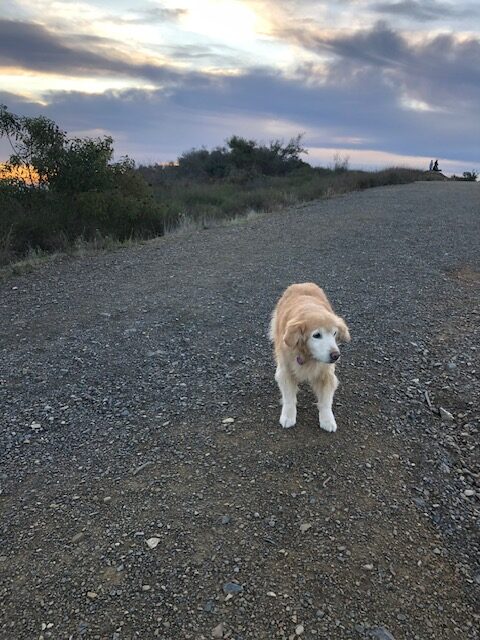
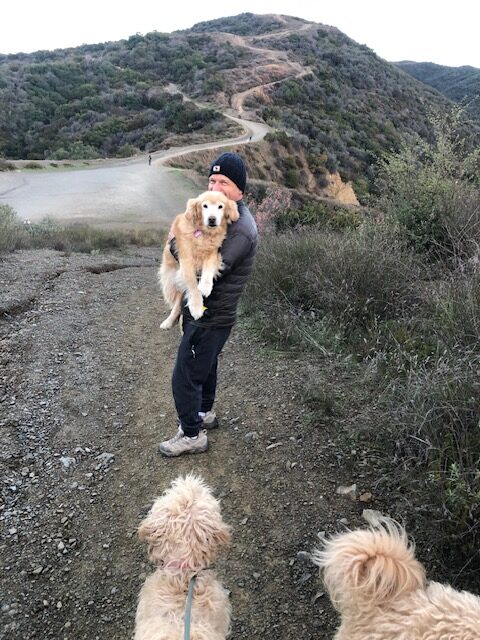
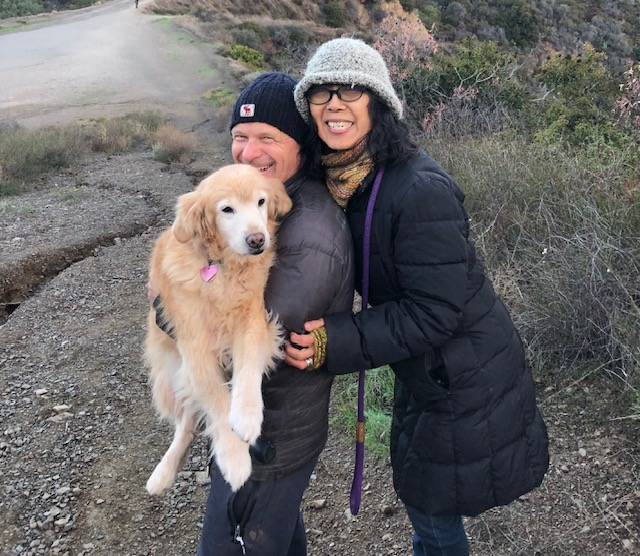

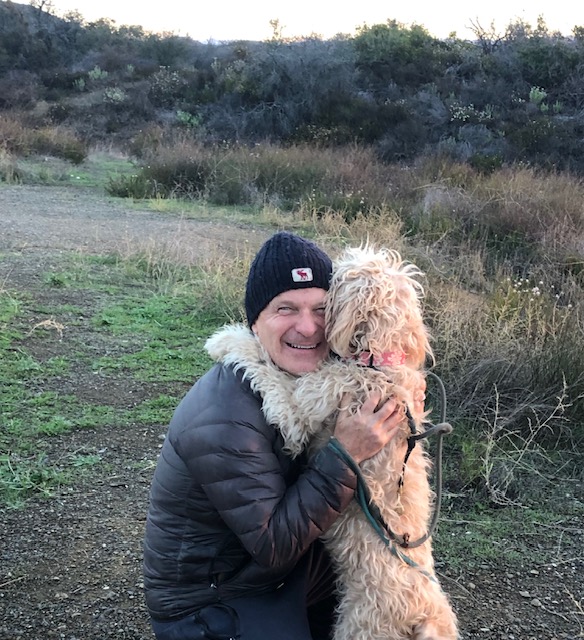
We came home and ate our New Years’s Ozouni (Japanese soup containing mochi rice cakes. The dish is tradition to eat with the Japanese New Year.)
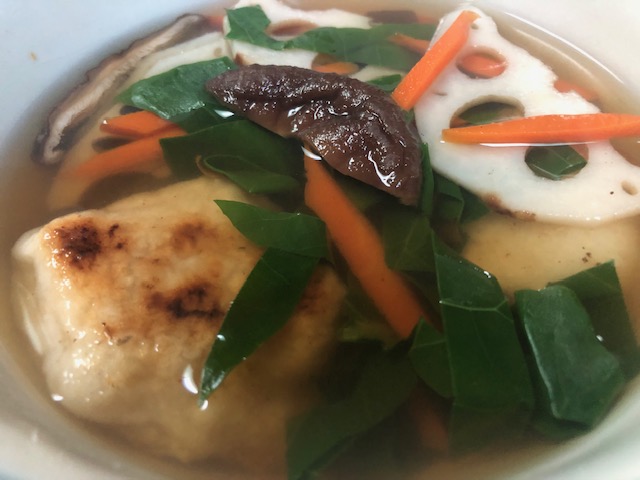
I did not have a big desire, but New Year’s sunrise rose and showed an incredible New Year’s sunshine again this year.
I am truly grateful.
With New Year’s Sunrise, I worshipped in good health, happiness, love, and healing for everyone globally.
Happy New Year to you all – Akemashite Omedetou!
Thank you/Arigatou!
Love,
Sanae❤️
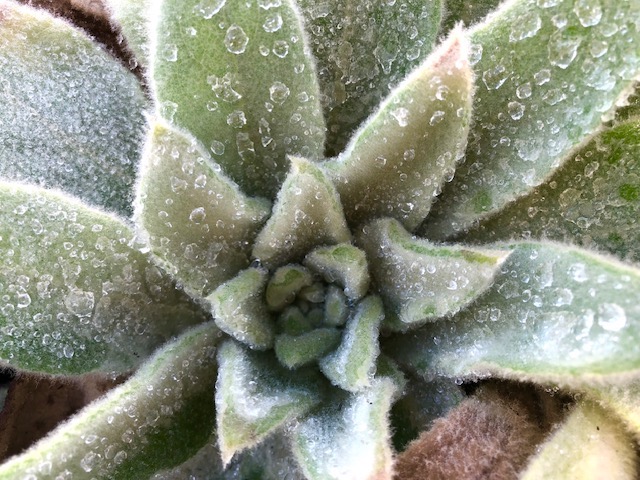
Reflecting on the Year 2023
It is almost the year 2023 completing.
Did you know Mercury retrograde on December 13 (this is 4th time this year)?
When Mercury retrograde occurs, it is said to have a variety of effects on our lives. for example…
Communication is not going well.
Transportation is delayed.
Poor internet connection.
Careless mistakes will increase.
and more. . . .
I am Aries.
Reading “The last Mercury retrograde of 2023 has eye-opening lessons for the zodiac signs” helped me for .
If you feel the walls are closing in on you, Aries, you may need to look sideways to find openings that lead you elsewhere. Creative, yet patient thinking backed with being quick-footed in times of need holds the key to forward movement for you. Watch out for emotional overwhelmedness and breathe through it all.
Anyway, so many things happened to my quiet life: my dog, Nalu, and I got attacked by a neighbor’s dog while we were walking in an alley and had to go to Urgent Care (it was not serious and the injury healed in about 10 days), the laptop crashed (had to go to the Apple Store in Santa Monica twice, and later had to talk to someone in India in order to speak to Santa Monica Apple store technician),
Eric’s van broke down (he had to take the Van to two locations to fixed), Eric and I had arguments, UPS’s package was delivered to the wrong location, somebody used my American Express, and yesterday I could not access my website’s dashboard to post my blog (I called for an hour to get the website fixed and was told it would take about 72 hours.)
Honestly, I got a little tired and was feeling down.
So I meditated with Eric, watched my favorite movie on Netflix, and slept.
This morning, when I refreshed myself and looked at the website, it was fixed! I am grateful that my website was fixed so now I am posting what I had written here.
By the way, Mercury reintegrated till January 1, 2024.
So… it rained a lot last night (December 29) in Santa Monica, where I live, and I was thinking about the middle of the night when I woke up because of the rain sound about what it would be like this morning, but then the beautiful sun came out.
I love the rain that falls in the middle of the night and the smell of “petrichor” from the morning sun.
“Petrichor” gave me the motivation to write about this past year.
According to Nine Star Ki astrology, the year 2023 was the season when I was in the winter-water position. It is the time of hibernation.
I didn’t hibernate in the past few winters, 2014, 2005, and 1996. I decided to take the courage to hibernate.
During hibernation, I set a schedule as floating water, working less, going out less, and teaching fewer classes.
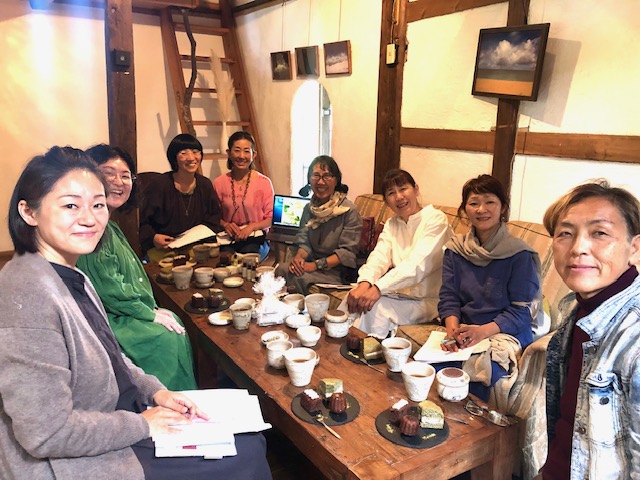
I stayed at home and cherished the time I had with myself.
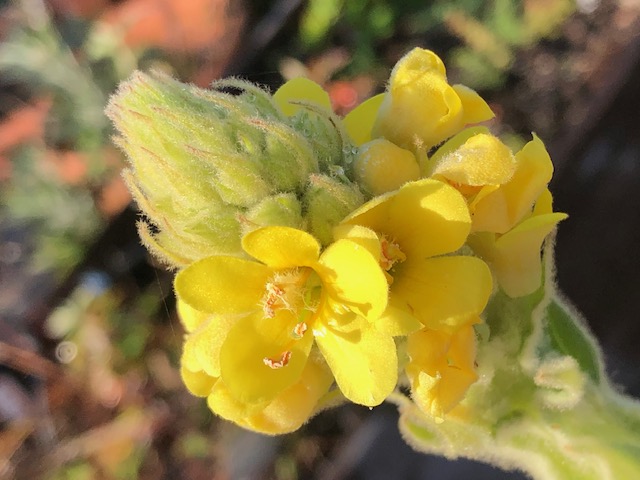
Grew vegetables, native plants, and medicinal herbs, watercolor, calligraphy, created naturally dyed fabric art, knitted sweaters, and started a draft of a new book.


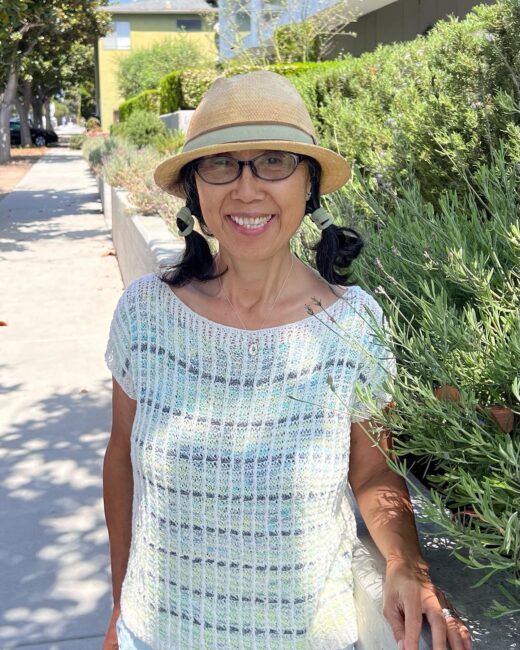
Also, I decided to take Jung’s psychology monthly class via Zoom in September to understand my inner self, and every month, I have learned so much.
I have learned to enjoy a slow-paced life much more.
My only big trip was to Japan for my niece’s wedding.
I wanted to write about it on my blog someday, but I have yet to be able to do so.
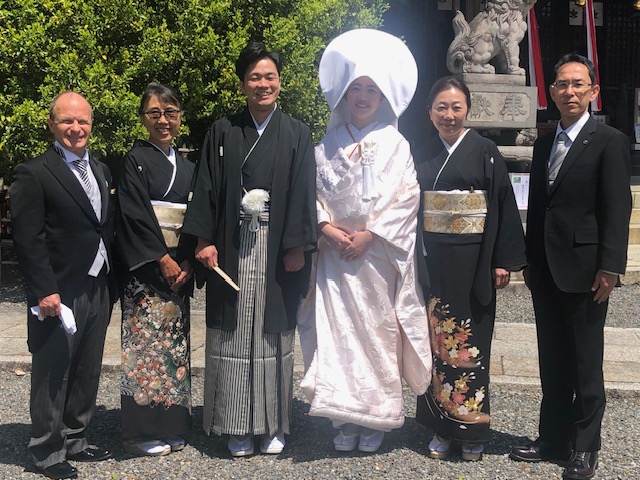
I was sometimes irritated by the hibernation and loneliness.
I know spring is coming, and I look forward to it.
2023 marks an important milestone: 5 years since undergoing Red Devil chemotherapy for stage IV lymphoma cancer. (Confirm that the first goal is one year, the next is three years, and the final goal is five years, so it does not come back.)
My medical oncologist, Dr. Mead, has not seen any severe complications in me since 2017, and I am on only medication for bone, which is due to chemotherapy that I lost bone density. During my checkup, she was pleased to see me receiving A five-year goal.
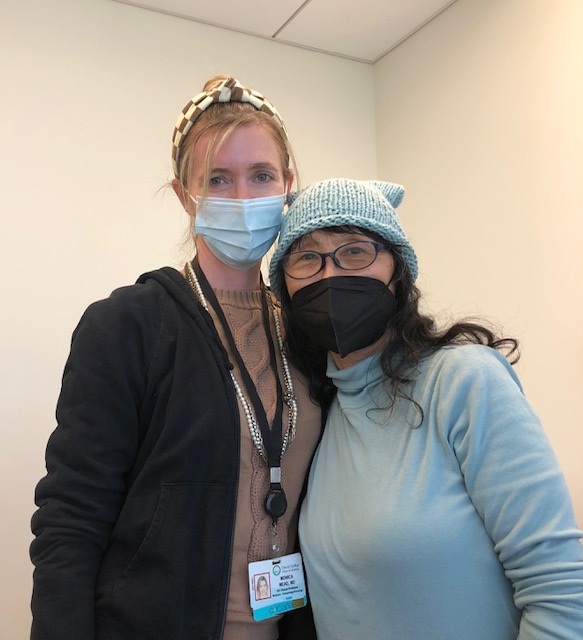
I told Dr. Mead that I was writing my stage IV lymphoma cancer recovery story and asked her if she could write the foreword. Once I finished writing the book, she agreed to write it for me.
I was happy to hear about it, so I wish I could write more, but I have only written the beginning of chapter 1 and all the chapter’s temporary titles so far.
It will take a long time for me to finish writing, but I stopped aggrandizing myself that I did not write more.
I know deep inside that I will finish it at my own pace and make peace.
I am grateful for my shortcomings as much as my strengths.
I appreciate the gift of my health, my husband, the animal family I live with, and my friends and family.
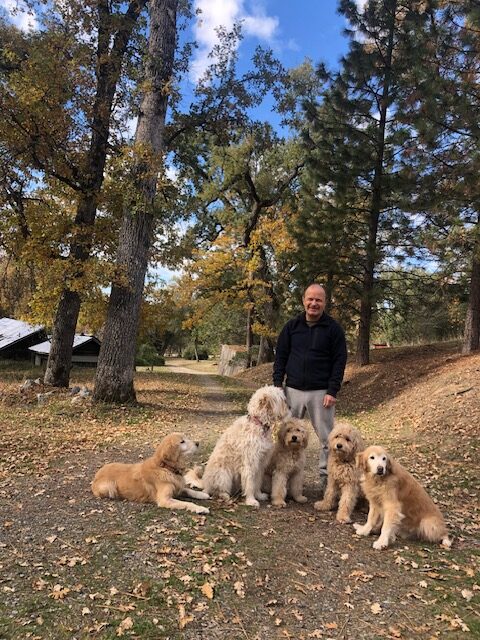
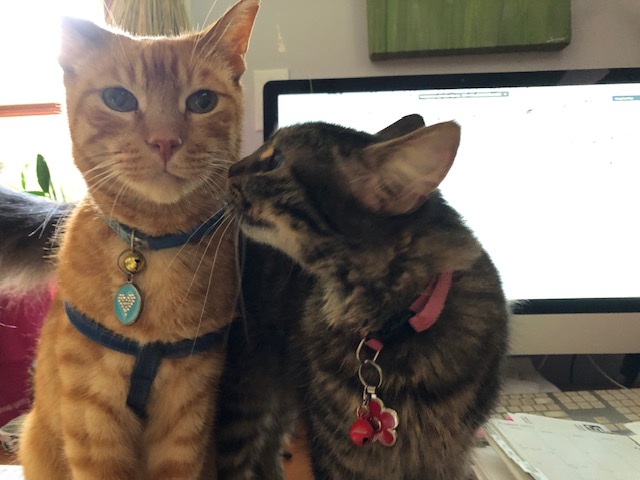
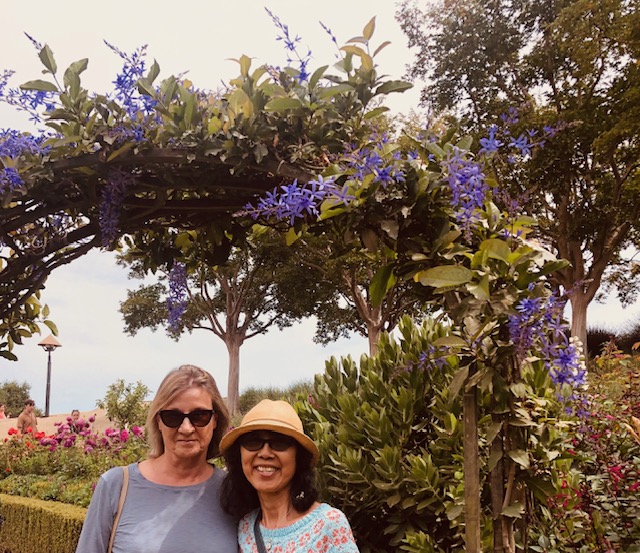
May 2024 bring you and our health, happiness, and love.
I look forward to creating a new, slow-paced life.
Love,
Sanae❤️
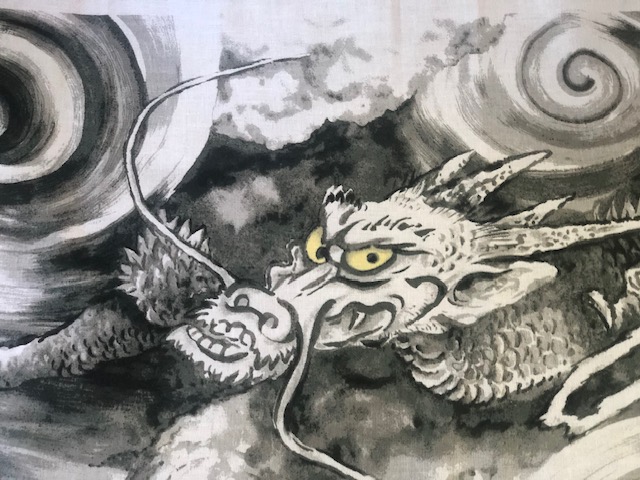
Japan Spring 2023 Diary Day 6 Kyoto
It was on my mind to continue writing about the trip to Japan last spring, but once I lost the rhythm of focusing on writing, I could not get back to setting my mind to write.
Early this morning, it was raining.
I was listening to the sound and feeling the moisture of the air.
It was more humid than usual, and I remember living in Japan.
Instead of turning around on my bed, I got up and watched how the rain was coming down.
I felt an emotional atmosphere and followed my feelings.
The sky was milky indigo dark, and the color changed just before dawn to almost dark purple, which I could easily miss.
The sound stopped for a moment before birds sang.
I love this color before dawn and the moment of silence, and I feel I can love myself even though I am not productively living when I notice them.
Finally, I got the motivation to write (took time to sort out the photos – now October, but I hope you enjoy reading and seeing the photos.
So here I am, “Japan Spring 2023 Diary Day 6 Kyoto.”
Kyoto has been a very popular destination for Japanese people and foreigners for a long time as the cultural capital of Japan.
My most memorable visit to Kyoto was on a school trip for my 11-year-old elementary school student. I still remember it vividly because I had to write a diary with photos and illustrations as homework.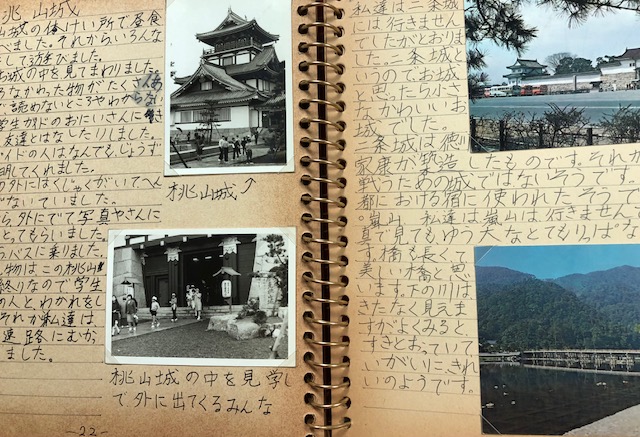
Ancient and modern cultures and buildings live perfectly together, making Kyoto attractive.
Kyoto People speak a soft, slow dialect, and their foods taste a little lighter than most Japanese foods, and even colors are pastel. 1600 temples and over 400 Shinto shrines in Kyoto.
It was my seventh time.
I woke up at dawn feeling excited coming to Kyoto once again.
When I looked out from my room at Hotel Granvia Kyoto, the sight of Japan Rail Kyoto Station and the mountain scenery lifted my spirits as if to symbolize that it would be a good day. (Kyoto is located in a valley, so I couldn’t see the sunrise from my hotel room)

That morning, I had agreed to meet Marie-chan for the first time in 8 years, so I met her at the Hotel Granvia Kyoto lobby. Eight years ago, she came all the way from Hiroshima to meet us and spent one night and two days with us. As I was thinking about the fun times I had while waiting, Marie-chan came over with a smile on her face.
She is a comrade who went to Kushi Institute together to study to become a macrobiotic counselor. She invited Eric and Me to teach at her macrobiotic school in Hiroshima.
On this day, She chose for us to visit Tenryuji Temple. (Tenryuji (天龍寺, Tenryūji) It is the most important temple in Kyoto’s Arashiyama district. Tenryuji Temple is one of the Kyoto Gozan temples, which are highly prestigious Zen temples in Kyoto.
The last time we came to Kyoto together, I could not walk much, so we took a taxi all over. I was confident to take a train this time, so we took a train from Kyoto station, where our hotel was. I checked how long and how much to go to Arashiyama from our hotel. By taxi: 15 minutes/cost $30 if there is no traffic, taking a train: 35 minutes/$2.
Taking a train and seeing local people and visitors riding was much more enjoyable and less costly. We also saw Twilight Express Train Mizuki at the station. Eric and I want to take the Twilight Express Train one day so we got so excited. Eric, Marie, and I had fun conversations and laughed a lot.
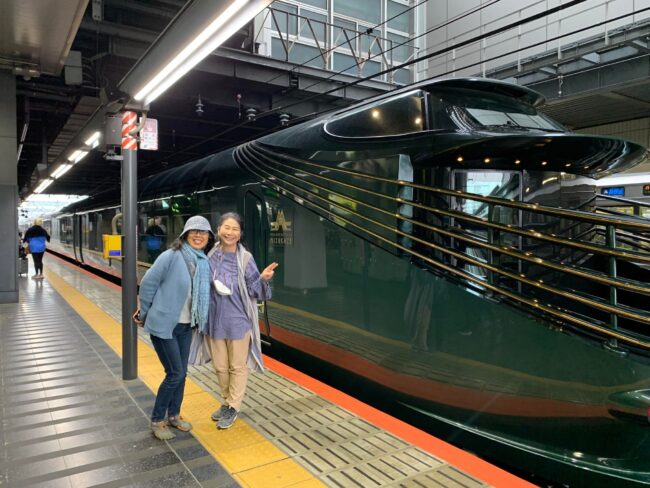

We arrived at Saga-Arashiyama station, and then we walked to Tenryuji Temple. We needed to figure out which direction to go, but we just followed people and reached the temple. There were many little shops on the way so it was difficult not to be distracted, but we decided to go our destination first.
As soon as we got to the temple, I decided to buy a new Goshuincho (-御朱印帳 is, if you want to translate it, a “book of seals.” Most shrines and temples in Japan have a Goshuin (御朱印), a seal that belongs only to that institution.) at Tenryuji.
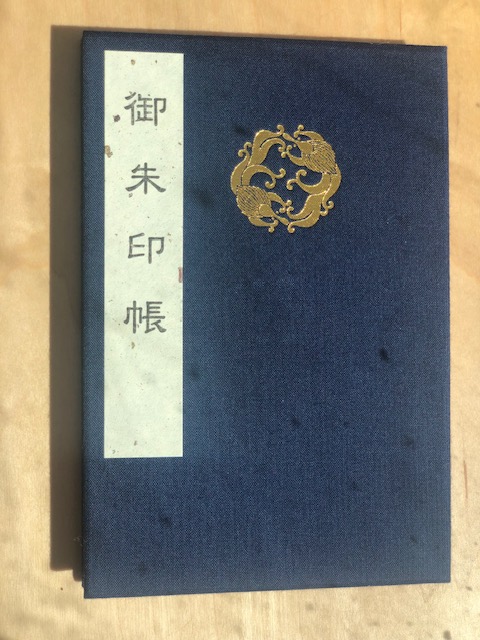
When my mother was still alive, she and I often visited temples and shrines to collect Goshuin. After my mother passed away, I couldn’t find where it went, so it was time for me to start anew.
Tenryuji Temple is said to be Japan’s first designated historical site and particular scenic spot, retaining the garden’s appearance created by Muso Kokushi approximately 700 years ago.
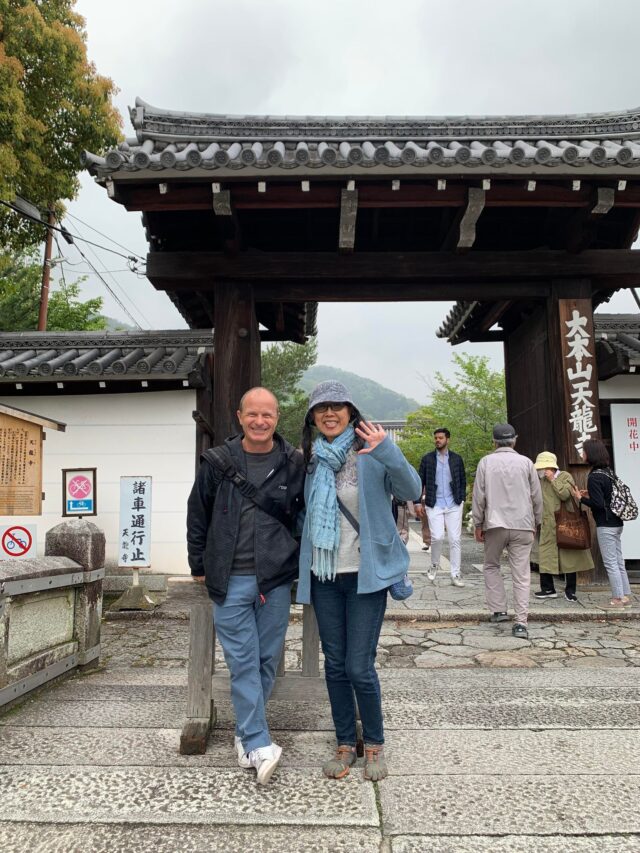
The cherry blossoms have already fallen this time, and the peonies and wisteria are fully blooming.
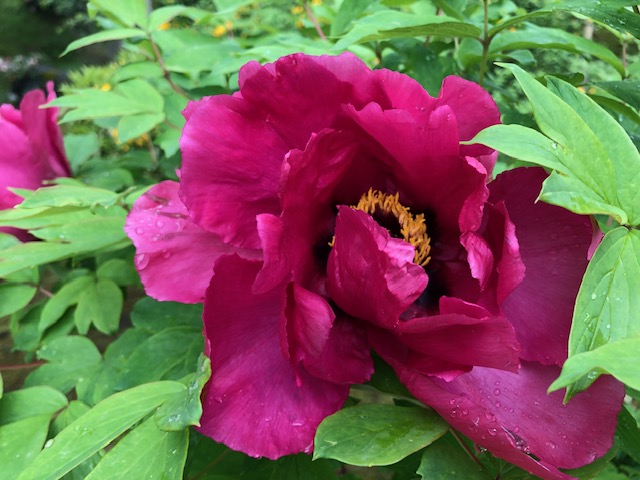
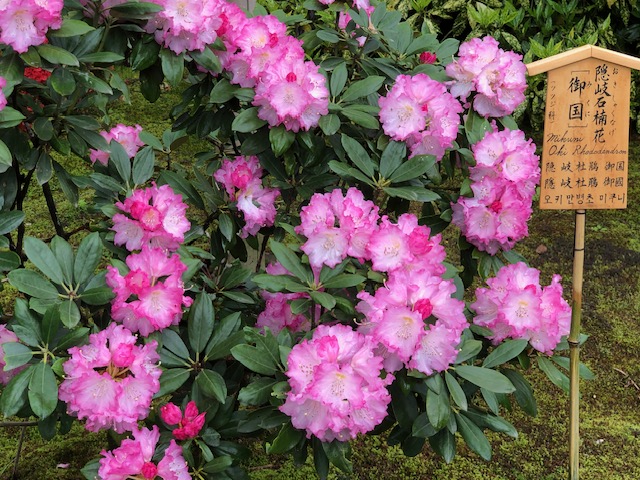
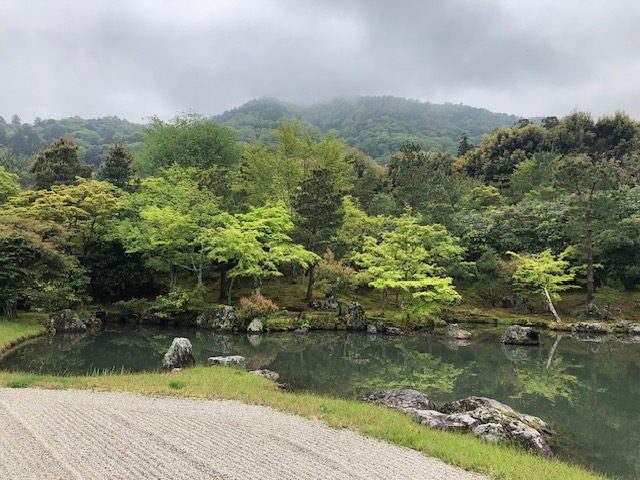
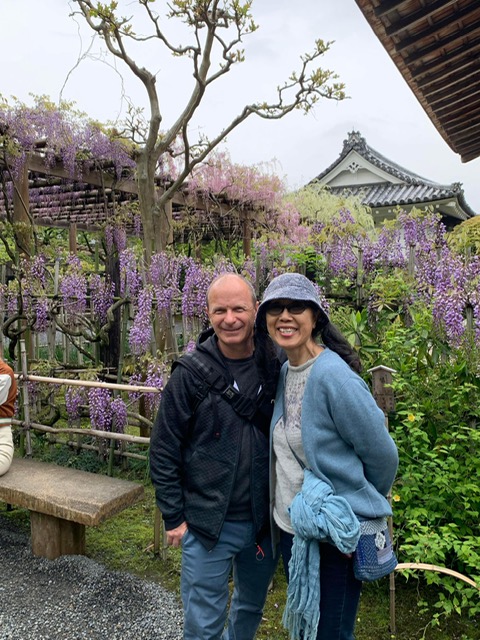
I could imagine enjoying beautiful scenery no matter when you visit, with weeping cherry blossoms in spring, fresh greenery in summer, red leaves in autumn, and snow in winter.
After the garden is the famous bamboo forest path, amidst the crowd, I was deeply moved by the power of the bamboo grove.
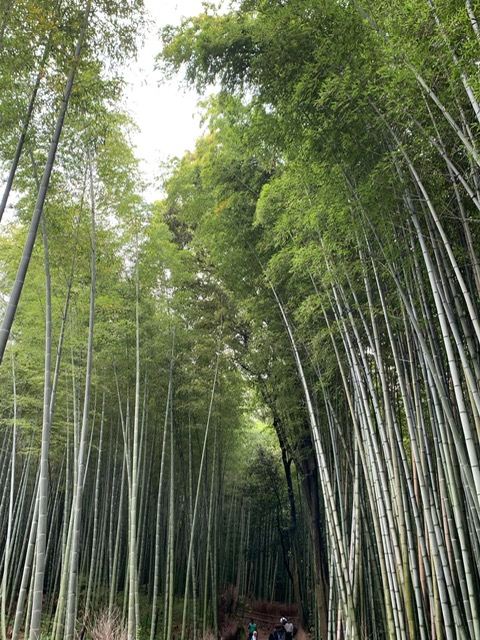
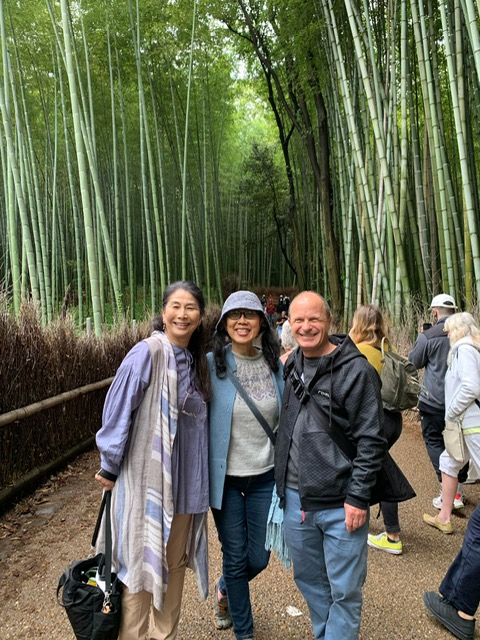
We walked a lot and got hungry. Marie already made a reservation for a lunch of Shojin Ryori at Shigetsu, a vegetarian restaurant inside Tenryuji Temple.
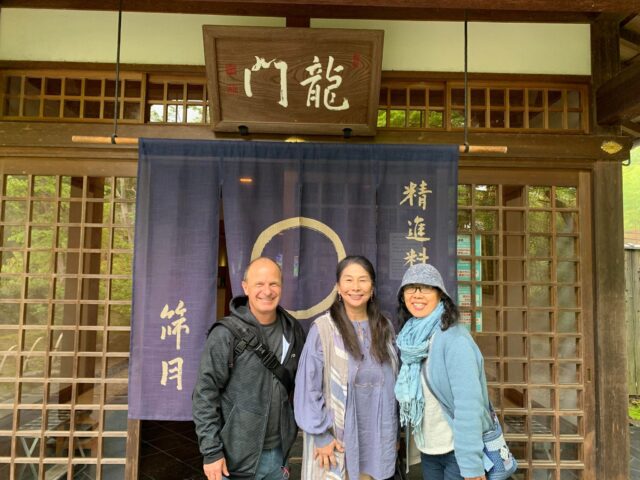
Shojin Ryori is a cuisine introduced from China during the Kamakura period (1185~1333), along with the teachings of Zen Buddhism.
Shojin Ryori(traditional Buddhist cooking):
It is a cooking method perfected to enjoy the freedom of mind that comes from the harmony of nature and the spirit of eating, which is part of Zen Buddhism’s training. It is a cooking method that is prepared with carefully selected fresh seasonal ingredients. It is a very healthy cooking method that uses vegetables, wild plants, and seaweed as its main ingredients without using any animal ingredients. It was very delicious, and the light, easy-to-eat dishes typical of Kyoto were the best.
It’s made without meat or fish and focuses on seasonal vegetables and mountain plants. Intense flavors such as garlic and onion are also avoided.) for lunch. It was exquisite dishes and delicious.
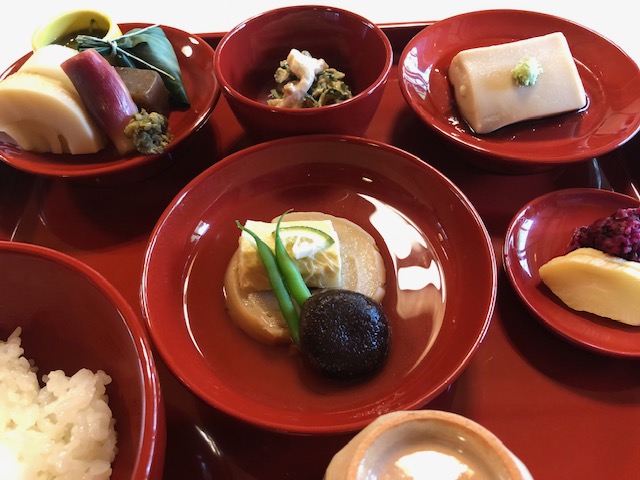
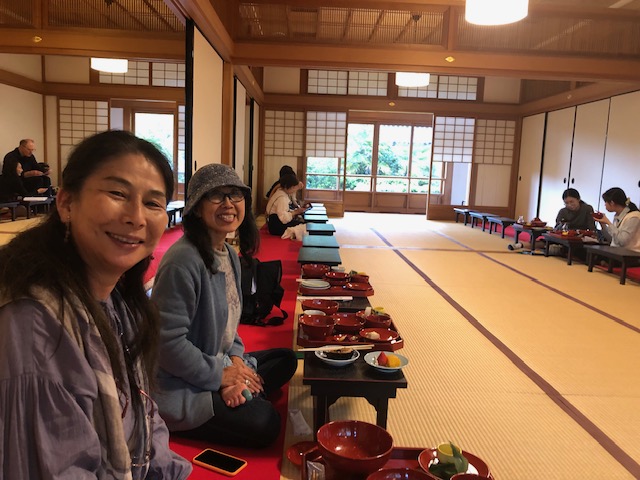
After the delicious special lunch, we could not miss Tenryuji’s Cloud Dragon before we left. The giant dragon with a cloud painted was so mysterious on the ceiling of the hall of worship. Apparently, it was painted by Japanese painter Matazo Kayama to commemorate the 650th anniversary of Muso Kokushi, the founder of Tenryuji Temple, and the first thing Eric noticed was that it seemed to be staring at him from any 360-degree angle. When he told me about it, I looked at him, and it seemed like he was staring at me everywhere I went. When I read the instructions, it said that the cloud dragon is called 八方睨みの龍 – “the Dragon staring in all directions” because it can stare at you from any direction. Since the temple did not allow us to take a photo, I thought you could get a feel for the atmosphere with the cloud and dragon towel that Marie-chan bought for me.
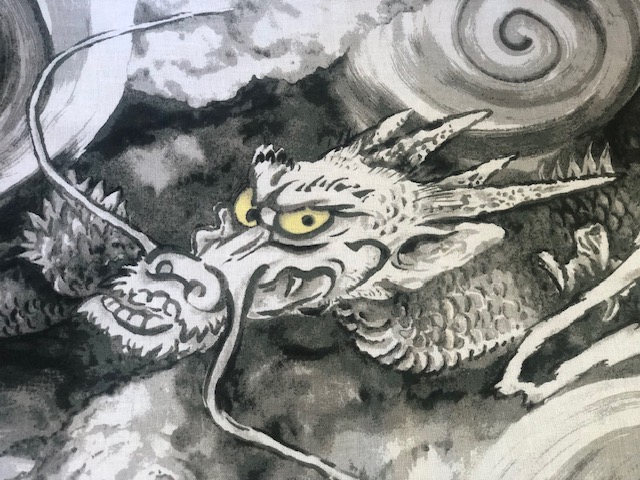
After leaving Tenryu-ji Temple, we walked along Arashiyama’s Togetsukyo Bridge. We found many souvenir shops, where I also picked up a Goshuin stamp bookcase with an excellent Kyoto-like design.
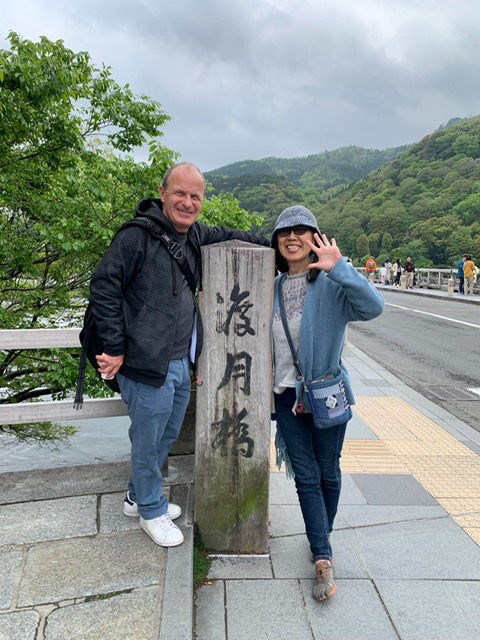
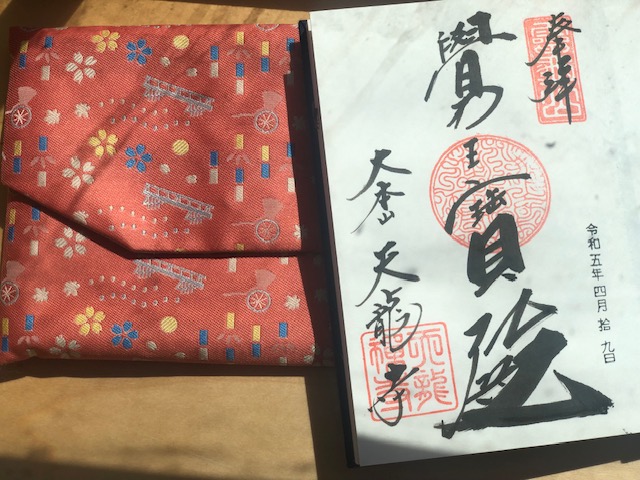
We sampled a lot, and Eric ate the soft ice cream made from yuba (tofu skin – non-dairy Yuba frozen soft cream), and Marie-chan and I happily hung out while eating steaming freshly roasted chestnuts with black bean coffee.
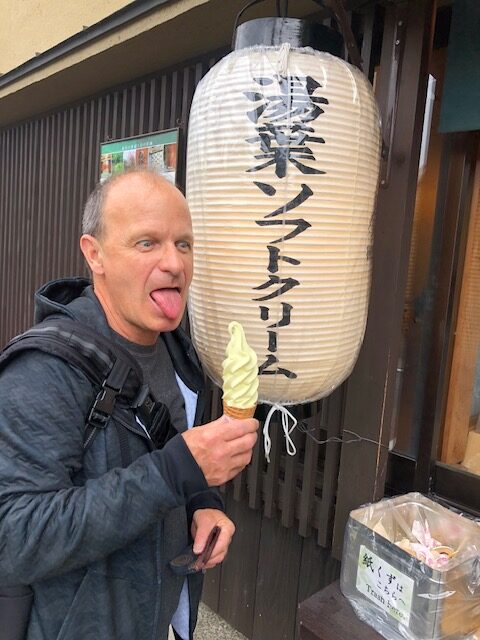
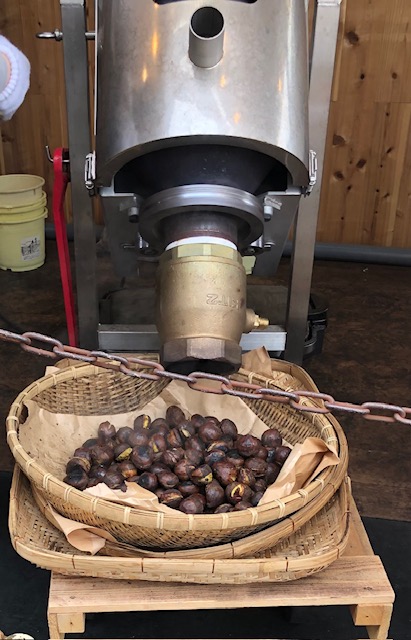
People in Kyoto wear more traditional Japanese Kimono clothes. I noticed that many rental Kimono shops are now available with choreography that is not old-fashioned but frilly and cute. Many young people are sightseeing wearing Kimonos made of synthetic, polyester, and acrylic fibers instead of expensive pure silk Kimonos.
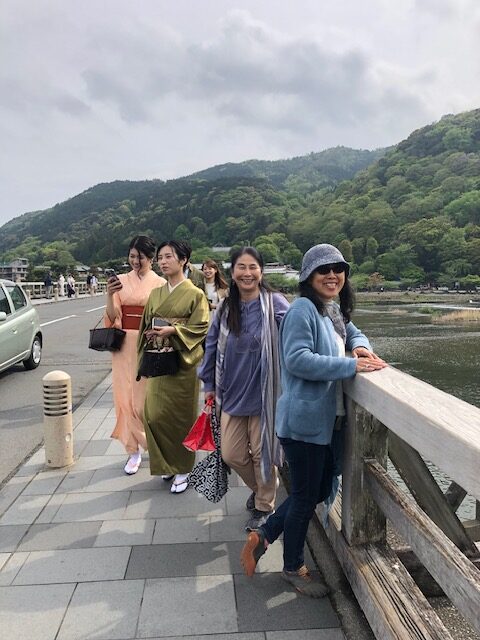
When we crossed Togetsukyo Bridge, gals were wearing a cute lace, more modern Kimono, so I took a photo of them with Eric.
The Kimono they wore was more modern, with frills and cute accessories. I thought it was lovely. It’s great to pass on Japan’s ancient culture in this way.
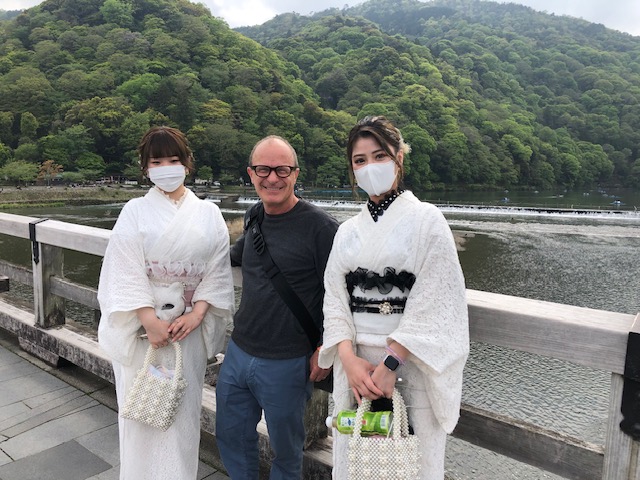
On the way home, I was shopping for souvenirs for my friends and neighbors who take care of our dogs and cats, and Eric found a cute orange polka dot pochette and wanted me to use it.
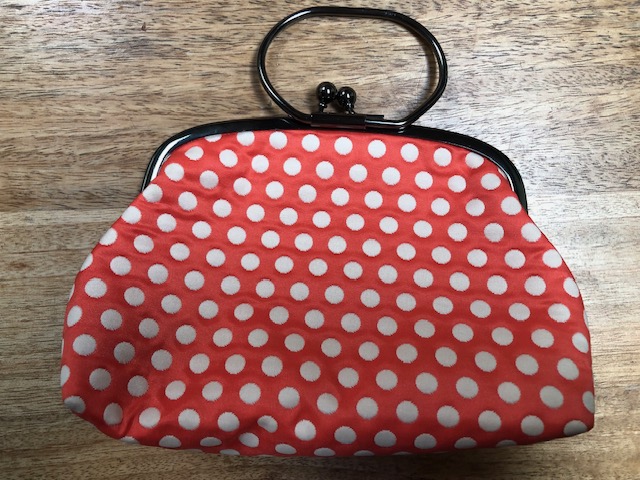
I thought it was too cute but accepted his kindness and gift.
After Arashiyama, we returned to the hotel and took a break.
We ate delicious Kyoto cuisine for dinner near the hotel and had a great time.
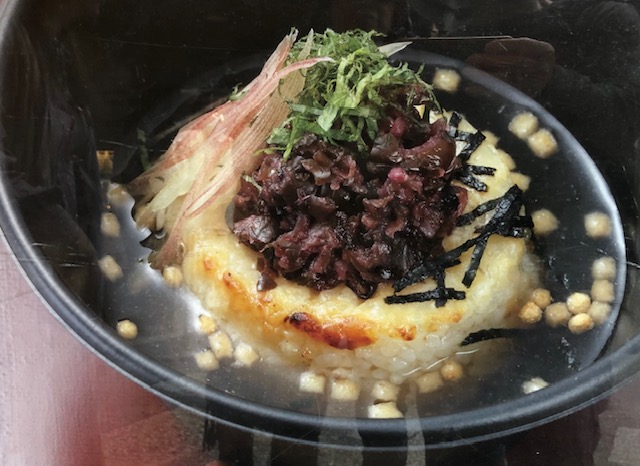
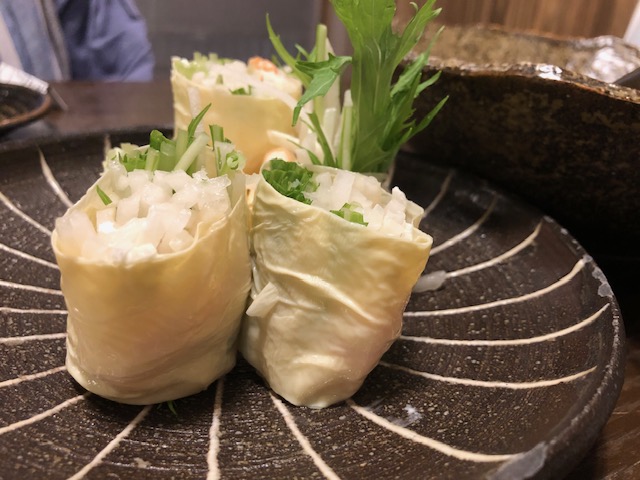
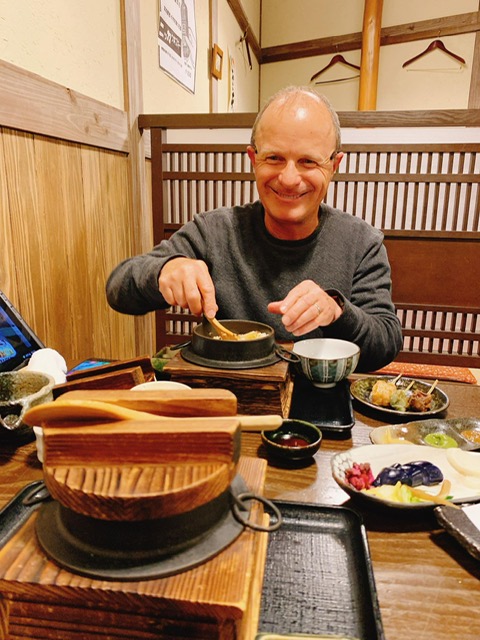
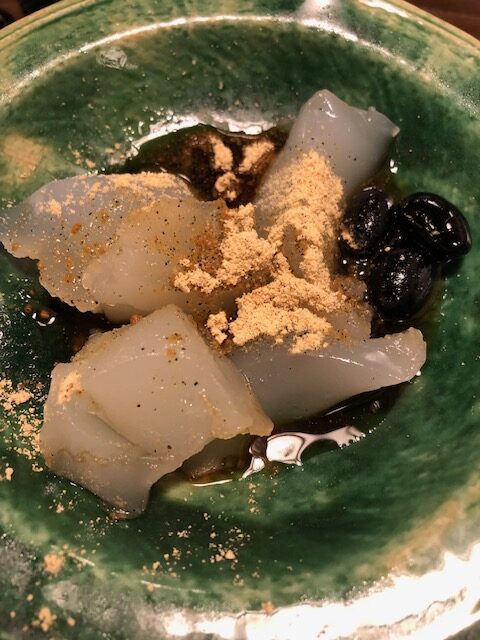
We all got excited about the Kyoto experience we had planned for the next day.
To be continue Kyoto trip…
Love, Sanae❤️

24 Hours & Balance
Every day, we have 24 hours.
24 hours is not enough time for my interests, the daily routine of what I must do, what I need to do, and what I should do.
Especially from spring to summer, seasonal hand-work becomes active, and how to use time becomes an issue and Balance.
How do you all use your day?
How do you balance?
I was writing a diary blog about my spring trip to Japan in May, but I stopped on the 5th day.
Because I use my time for counseling and healing sessions for those who have been coming to seek my help at work has increased, and to balance my physical condition, I needed time to rest.
In addition, the chemotherapy treatment I received for stage IV Non-Hodgkin’s lymphoma in 2017 (you can read about it Only Weeks Live!) caused my bone density to decrease, so I started going to the Santa Monica yoga studio (where I became Yoga Teacher – my blog “Yoga for My Life“) again on the doctor’s recommendation to strengthen my muscles and bones.
(During the pandemic, I was doing yoga online, but it’s refreshing to go to the studio and do yoga with the teacher and everyone.)
As I was finishing my spring sweater (California Poppy/orange flowers and Blue Sky images), the weather got warmer.
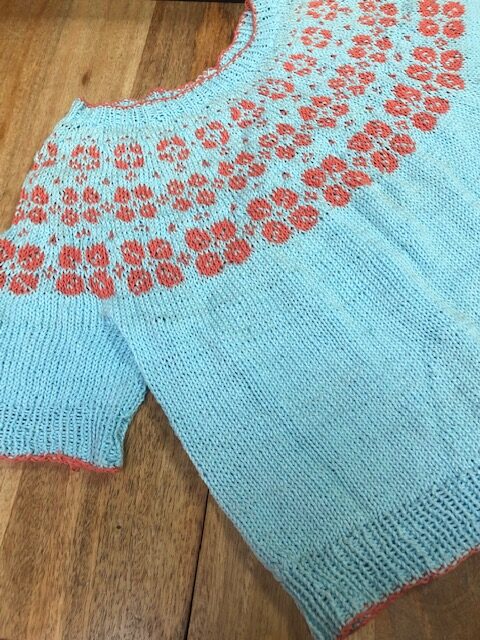
I have been doing more garden maintenance – artichoke flower on my rooftop garden (first photo) and Native Wild Plating sign at my house sidewalk garden,
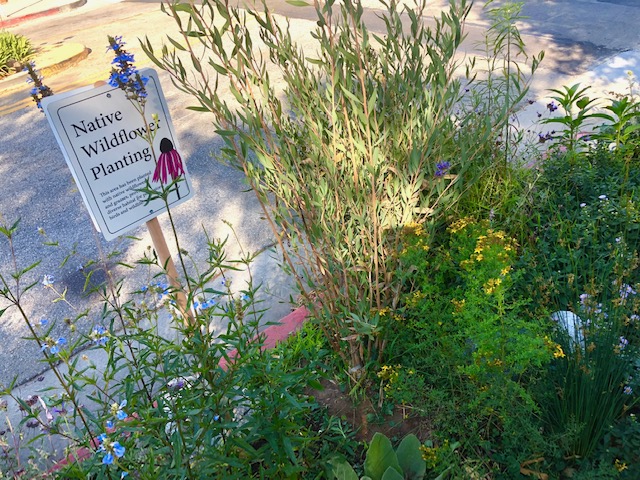
made Japanese umeboshi pickles and ume plum jam for this year,
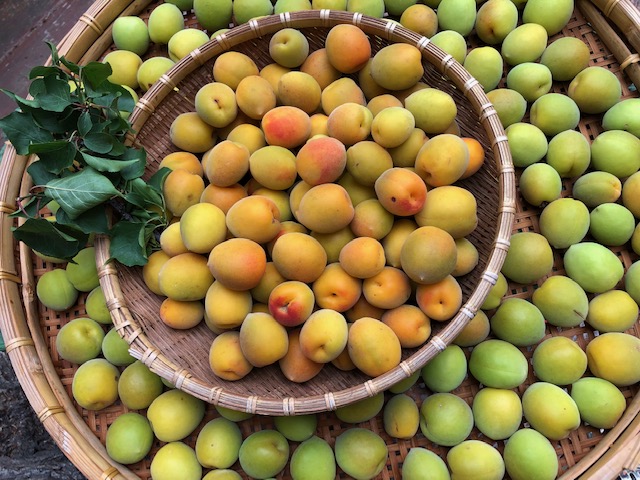
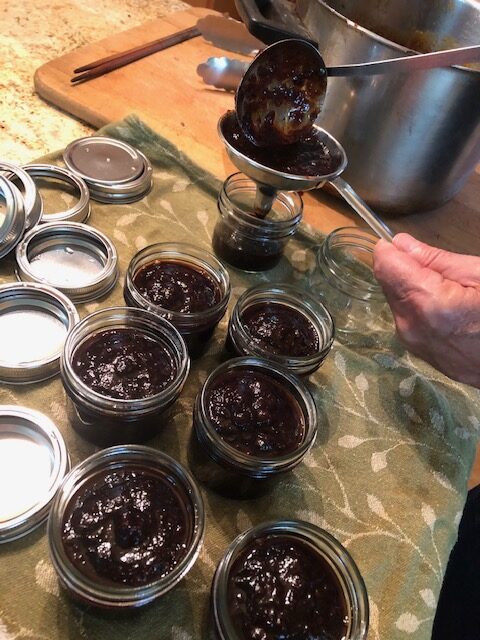
harvested wild elderberry flowers in North Fork (Eric took care of all the trees felt in winter and weed whacking there) to infuse them for Autumn to Winter skin toner and oil,
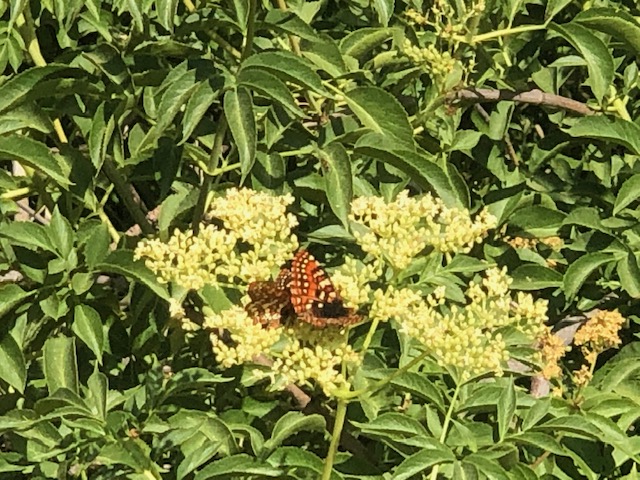
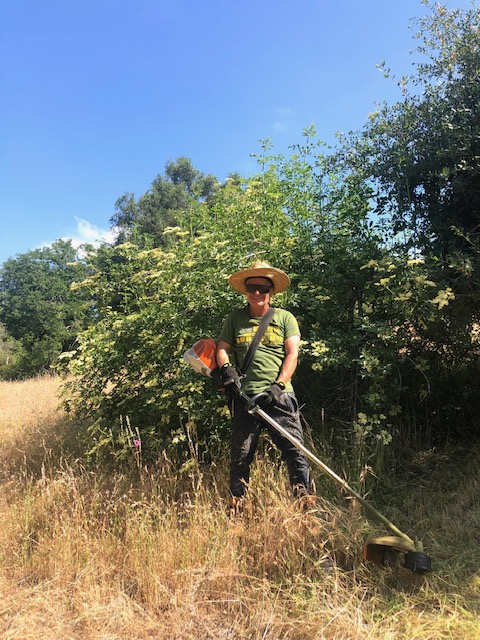
finished the assignments for my watercolor painting class,
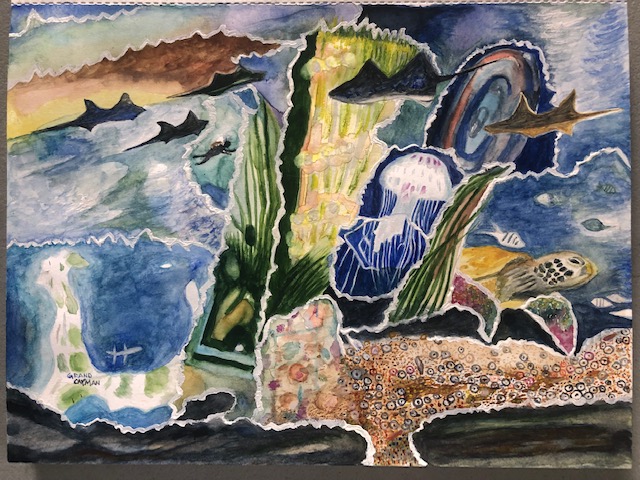
celebrated our 19th wedding anniversary and went to Getty Museum and new plant based restaurant “Planta” in Marina del Ray,
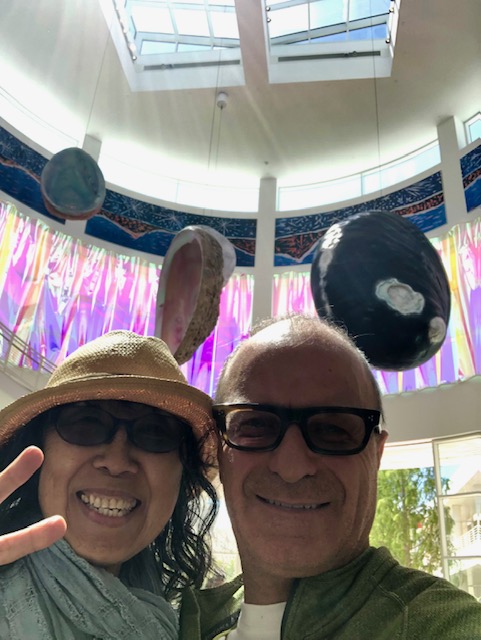
started a summer sweater knitting club at Wild Fiber studio in Santa Monica,
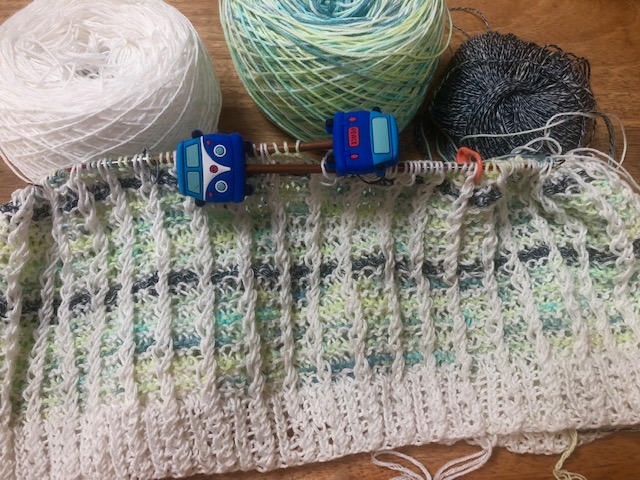
went to cheer on Eric at a SUP race with Kai,

made mosaic table with the wood table and tiles that we found in an alley while we were walking dogs.
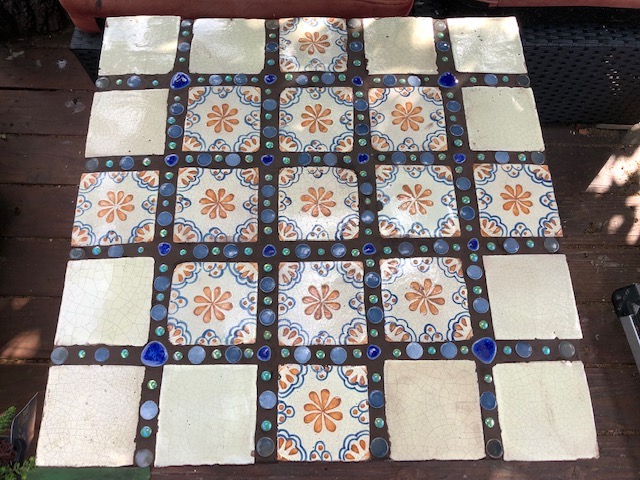
In addition, my daily routine of making remedy drinks and having homemade macrobiotic meals, going walks, meditation, body scrub, listening to old records music, massaging my feet, and applying moxibustion treatment; plus, my friend’s dog stays for three weeks, take care of the garden and mailbox for two weeks while the neighbors are away, giving a healing session for our eldest dog, Lumi, and cat, Tintin, and making birthday cards for my sister and brother and sending their gifts to Japan, so on, and July came already. There was no time to do Instagram/Facebook and blog.
Writing is one of my favorite things, so I think about it every day.
Writing takes a lot of time, so I feel like writing when I find decent time. Today while I thought of writing, I found time, so here I am.
Thinking about Balance.
I read my Nine Star Ki Astrology chart again since the last time I read it was at the beginning of this year.
I am “Nine Fire” in Ninet Star Ki Astrology.
It means I am in a year of relatively quiet time planning “Winter – water, floating, silence” this year.
Lately, in the morning, unless I have to, I wake up slowly and don’t act too rapidly, so I feel like I’m floating.
In winter, everything seems dead (sleeping) on the surface, but much life and activity is underneath.
Similarly, it may feel like it takes time, but it’s important to focus on this time to reflect, review, and plan for the future.
It’s quite different from the traditional fiery Nie Fire character, so I feel a bit uncomfortable.
Still, it’s a time for the opportunity to explore the beauty of the infinite universe and the depth of my inner being.
From my experience, intuition increases as the material aspect loses meaning and becomes secondary.
Although my finances may decline, my spiritual growth will surely gain momentum, so it is an excellent exercise to remember to find a balance.
Remember that all things need contrast in order to find Balance, and quiet moments like this are necessary for me to regroup and dive within to find my next move.
I have many activities physically and mentally most of time, so my balance method choices are “Take a good Rest” and “Vipassana meditation.”
Through deep engagement with existing spiritual practices and meditation, one can experience tremendous personal growth, a deeper understanding of one’s relationship to the universe, sudden flashes of insight, and heightened intuition.
I believe that if I put in the effort, I will discover the infinite wells of knowledge the universe offers.
So this summer, I teach only the Healthy Happy Holistic Care for Dogs and Cats class at the online Macrobiotic Conference and no other classes.

I will take time to finish writing my blog from the 6th day of my spring Japan trip diary, so I tell myself, “Let’s enjoy the moment to float without rushing.”
Love,
Sanae❤️

Japan Spring 2023 Diary Day 5 Tokyo to Kyoto
When I go to Japan, I always want to go to as many places as possible, do many things, and meet as many people as possible, so my schedule gets packed, so this time, I decided to take a trip without cramming.
So instead of going to the friend we were supposed to meet that day, we took a leisurely morning, walked with Ringo-chan with Kyoko and Shigeru, and went shopping for the ingredients Eric would make for lunch.
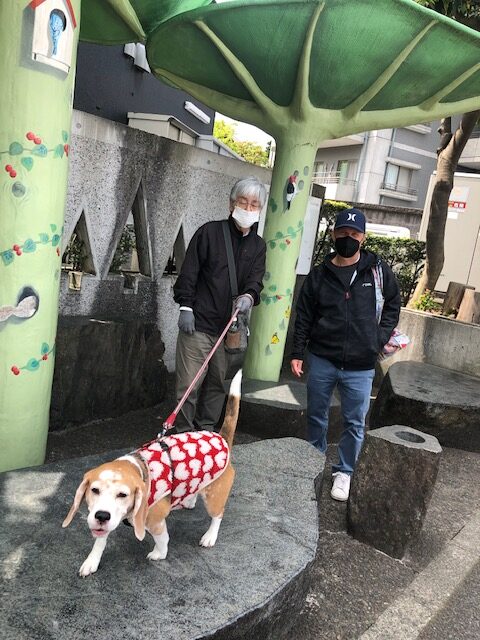
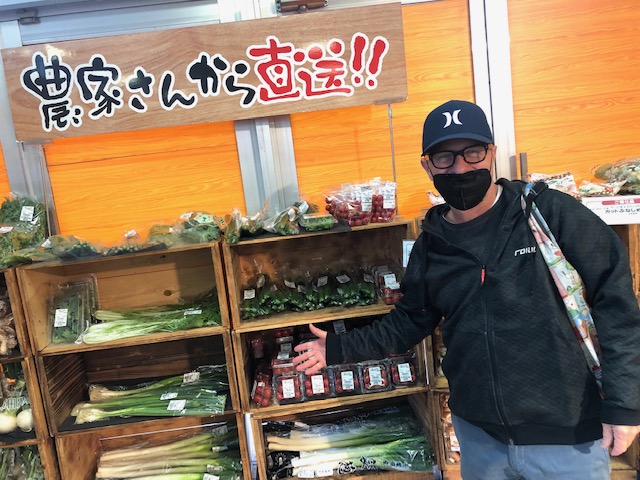

Eric cooked for Kyoko and Shigeru for lunch using spring seasonal firefly squid. They said it was too beautiful, elegant, and delicious to enjoy eating it.
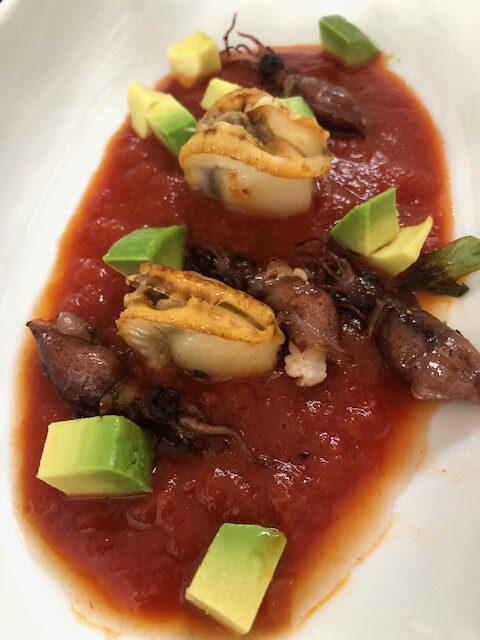
I followed my friend Kyoko’s advice to take the Shinkansen from Shin-Yokohama instead of going from Tokyo station to Kyoto, and it was right.
The transfer went smoothly, it wasn’t crowded, and Eric was as excited as usual when he saw the Nozomi Shinkansen in Shin-Yokohama.

He was filming a Shinkansen video, and the station conductor shouted at him and warned him to stay farther away, but I am sure Eric didn’t hear it, nor did he not care, so he continued filming.
Shinkansen’s ride was smooth and comfortable.
As I rode, I remembered that riding the Shinkansen to Tokyo was one of my favorite things to do when I was in high school.
At that time, Shinkansen was about 3 hours from Shin-Yokohama to Kyoto, but now it’s faster, about 2 hours or less.
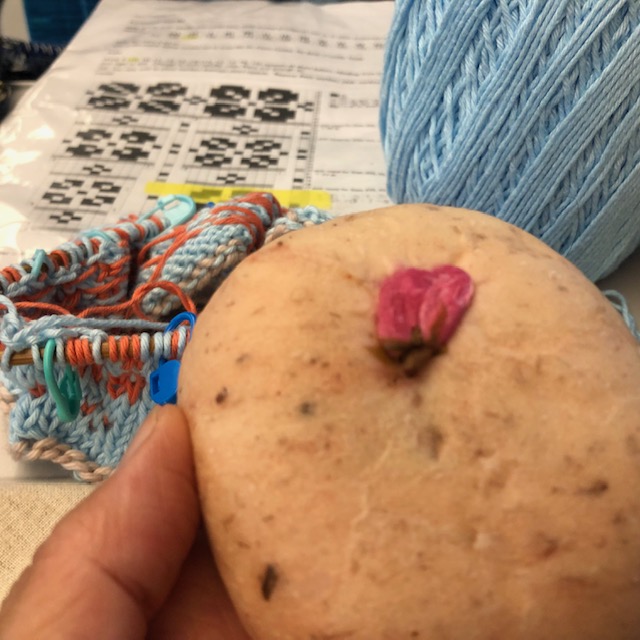
So we arrived in Kyoto before we knew while I was eating Chihiro’s cherry blossom azuki buns as a snack and knitting the spring sweater that I started knitting on the plane.
I decided for us to stay at a hotel in Kyoto. Kyoto is the tourist’s number one destination, so they were fully booked.
Luckily, after searching online, I found Hotel Granvia Kyoto, which is very close to Kyoto Station, so I read up on what kind of hotel it was. It’s directly connected to the Kyoto station building, so even if it rains, we don’t have to go outside with our pieces of luggage, so I decided immediately.

When we arrived at Kyoto station, it was not as crowded as Tokyo Station, but I wanted to make sure where we were going, so I asked the way to the entrance of Hotel Granvia Kyoto.
When we got off the Shinkansen and turned right, I was told there was a hotel entrance.
We found the entrance, and after going up the slightly dark stairs at the entranceway, I noticed we were walking on a glass-covered bridge that seemed to let in a flash of light.
What is this? While saying that, I noticed we were above Kyoto Station.
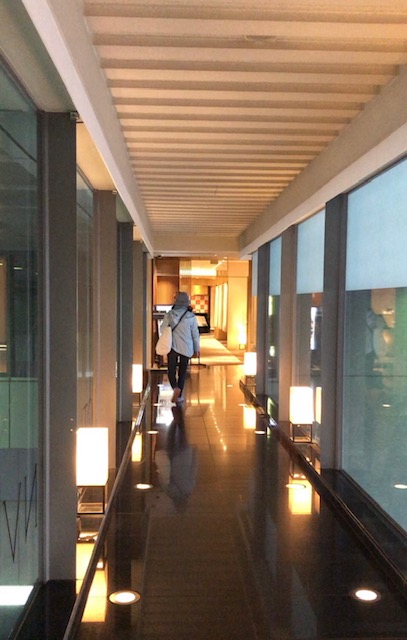
The right side was the JR trains track area, and the left side was the Hachijjou guchi entrance of the Kyoto station southside.

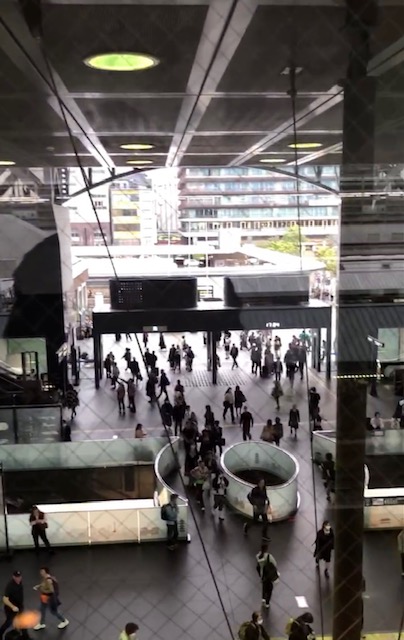
It’s an extraordinary view, and it’s meta at first sight that various people are walking and hurrying. We had never seen a train station from above before, so Eric was excited the second time that day and started taking videos.
After crossing this glass bridge, there was a row of lovely shops and an elevator to the lobby.
As I write this, I want to return to Hotel Granvia Kyoto and spend time in its surroundings.
I usually like hotels and Ryokan with gardens and traditional Japanese inns, but I was drawn to this hotel for some reason.
Our room had a view of the station on the Shinkansen side, so when we opened the window, we could hear all the sounds of the station, and when we closed the window, we could hear almost nothing. I was impressed with this windowpane. The beautiful scenery of the mountains on the south side left an impression on me.

While I was resting in our room, Eric explored and discovered a delicious yuba (Tofu skin, Yuba, beancurd skin, beancurd sheet, or beancurd robes is a food product made from soybeans. ) and homemade tofu, Kyoto Vegetables restaurant Seppourai next to the hotel.
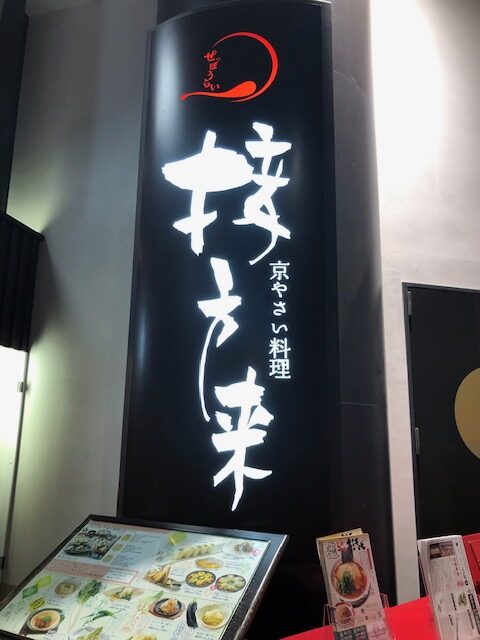
He came to invite me to have dinner there.
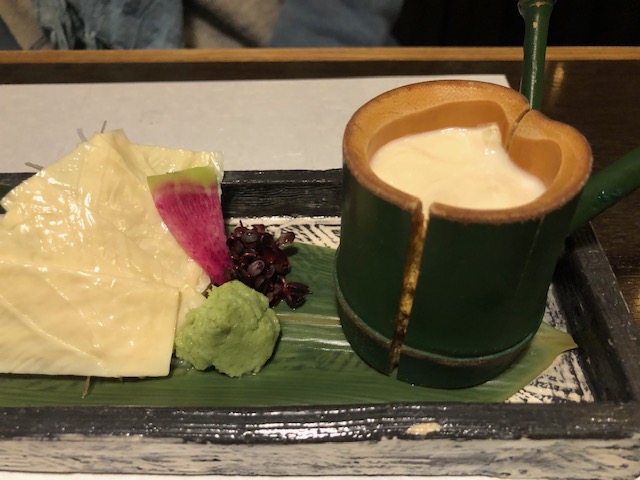
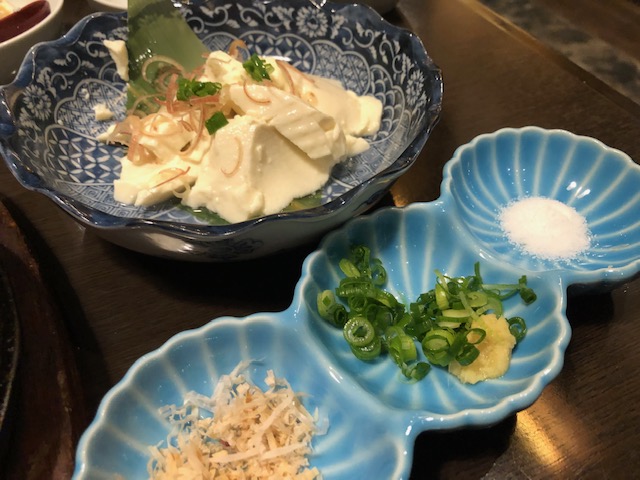
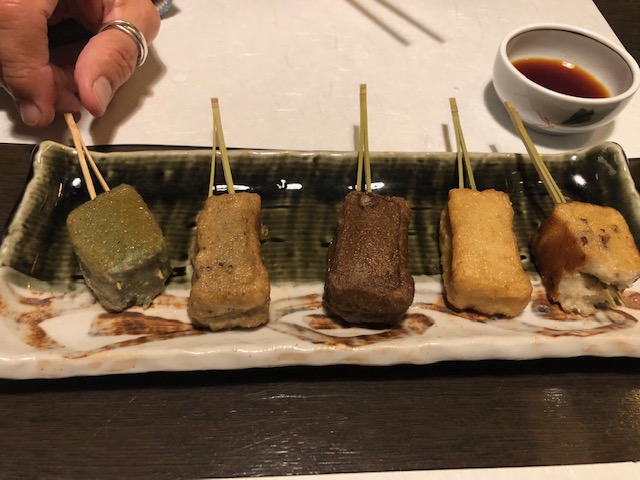
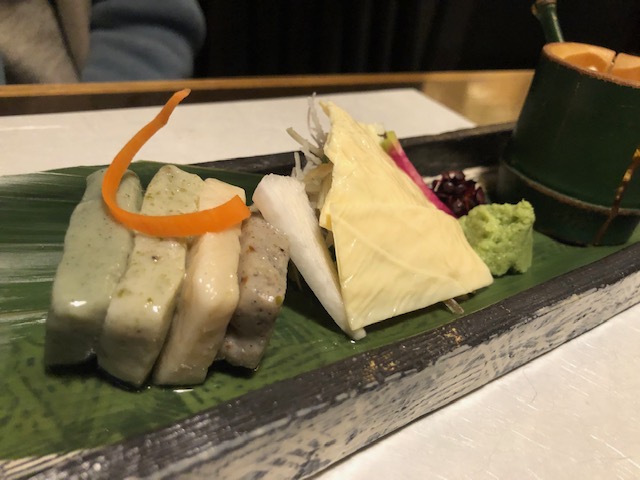
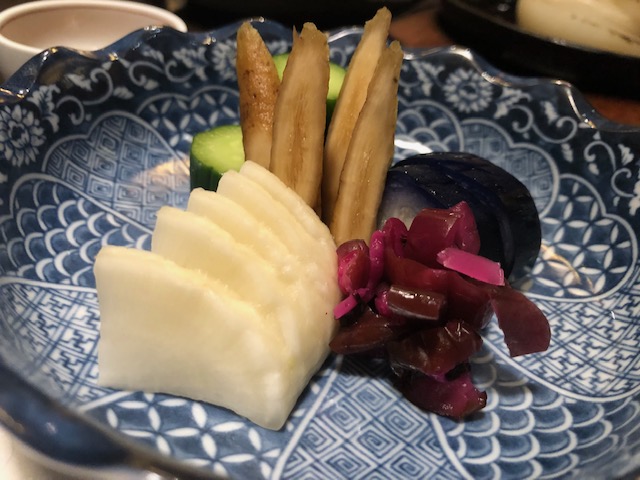
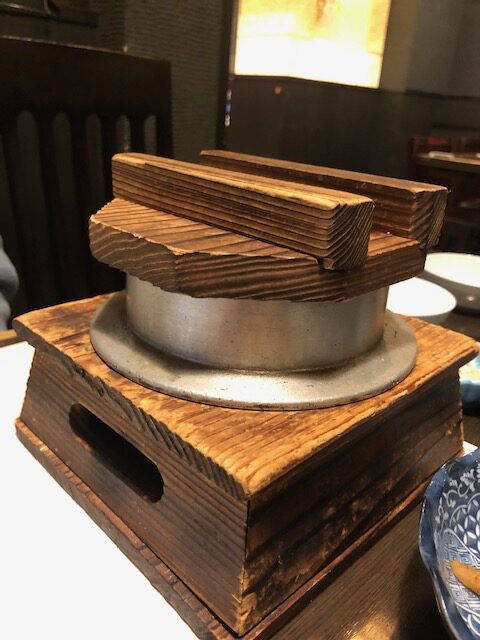

We ate to our heart’s content at the delicious yuba and tofu restaurant, walked around a bit, browsed souvenir shops and bakeries, and returned to our room.
Relax in a modern Japanese bath which Eric was excited third time that day to videotape.
Had my homemade bath salt with my garden Calendula and North Fork pine.
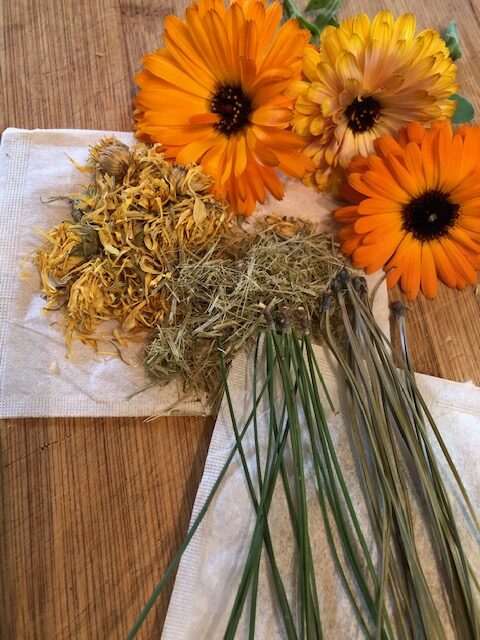
And we had a good night in Kyoto for the first time in 8 years.
Love, Sanae

